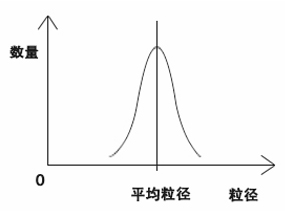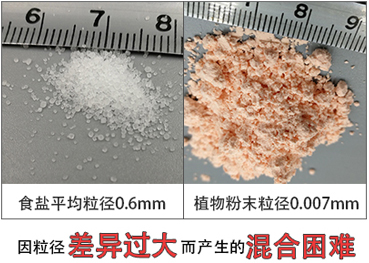Usually, the particle size of the powder we refer to is the average particle size of the powder. The size of the powder and the difference in particle size are important factors that affect the uniformity and mixing of the powder.
1、 Particle size of powder
1. Powder particle size
Powder particle size represents the size of a single powder particle, represented by powder diameter. Generally measured in micrometers( μ m) ; It is also commonly represented by the number of items. The vast majority of powder particles have irregular shapes. For an irregular particle, the measurement methods for its particle size vary, its physical meaning varies, and the measurement values also vary.
2. Equivalent particle size
Definition of equivalent particle size: When the physical behavior or parameters of an irregular particle are the same or similar to those of a sphere with the same material, we refer to the diameter of the sphere as the equivalent particle size of the irregular particle. When the reference physical behavior or parameters are different, measuring the same irregular particle may result in multiple equivalent particle size values.
3. Particle size in practical use
The particle size in practical applications is not accurately described because the actual situation of the powder is very complex (such as the shape of the powder particles, the surface shape of the powder, calculation methods, etc.), and detection methods are difficult to achieve precise goals. Therefore, the particle size used in practical applications is only an approximate value of the powder particle size.
4. Average particle size and normal distribution of powder
The basic characteristic of powder particle size is a normal distribution centered around the average particle size. The number of particles is highest near the average particle size, and decreases with the change of particle size, as shown in the figure below.

Usually, the particle size we use is the average particle size of the powder.
5. Representation method of particle size
① The particle size can be expressed in centimeters (cm) or micrometers (µ m) as units.
② The particle size can also be expressed in mesh units.
The meaning is how many mesh holes (i.e. the number of mesh holes in a sieve) are contained within a square inch of area, for example, 100 mesh means 100 mesh holes in a square inch. In practical applications, the size of the sieve mesh aperture is commonly used to represent the particle size of the powder.
③ Conversion relationship between two units of particle size: micrometer and mesh number
50 mesh=300 microns
100 mesh=150 microns
500 mesh=28 microns
1000 mesh=14 microns
2000 mesh=6.5 microns
5000 mesh=2.7 microns
Other mesh units can be approximated by analogy.
2、 Measurement method of powder particle size
1. Screening method: Generally used for powder materials. When using the screening method to determine powder particles, the material is divided into a set of samples with different mesh sizes to determine the percentage content of various particle sizes. For example, if you need 200 mesh powder, you can choose to pass through 150 mesh undersize and 250 mesh undersize; Requires -200 mesh powder, simply select the material below the 200 mesh sieve.
2. Electron microscopy method: For powder particles with relatively small particle sizes and ultrafine powders, optical microscopy method is generally used. The microscope method is the only method that can observe powder particles and measure particle size, and is considered a relatively perfect way by scientific workers. 3、 The influence of powder particle size on mixing
The average particle size of the powder is also an important factor affecting mixing:
1. Mixing powders with similar particle sizes can easily achieve uniform mixing:
This is because under the same other conditions, the same particle size of the powder during movement is less likely to cause segregation, resulting in a smooth and uniform mixing of the powder. 2. The difference in powder particle size is significant, making it difficult to achieve uniform powder mixing:
This is because the smaller the particle size of the powder, the finer the powder, and there is a tendency for the powder to float up when mixed. On the contrary, the larger the particle size of the powder, the coarser the powder, and the powder tends to sink when mixed. This leads to segregation phenomenon and brings difficulties to mixed work.
For example, the mixing of large particle salt powder and small particle plant powder in the following figure poses difficulties in uniform mixing due to the significant difference in particle size:

Solution: It is to crush and grind the large particles of salt to make their particle size appropriately close to the plant powder, which can reduce the difficulty of uniform mixing.
3. The difficulty of mixing ultrafine powder (powder with extremely small particle size):
When there is a powder with a particle size less than 1000 mesh in the mixed powder, it is called ultrafine powder. Due to its high floating ability, ultrafine powder can float up with very little kinetic energy in the mixing equipment, which makes mixing difficult.
Causes and solutions of the problem:
Ultrafine powder generally refers to powder with a particle size less than 1000 mesh or 2000 mesh. For a single type of powder, when the average particle size is reduced to a certain extent, its physical characteristics will undergo significant changes, and what did not originally float will become floating. After ultrafine particles are refined, their inherent gravitational constraints are significantly negligible. Without gravitational constraints, their mobility becomes apparent, and the mutual adsorption, agglomeration, and electrostatic interactions between powders become prominent, making it difficult to mix.
Solution:
① Reduce the movement speed of the mixing equipment, increase the filling rate, and load it to 85% of the mixing container to avoid the floating motion of ultrafine powder as much as possible. Loading more is to reduce the possibility of ultrafine powder floating and increase the pressure between powders.
② Choose dual motion ® The mixer utilizes the binding effect of the joint movement of its container and blades to press the ultrafine powder floating above the container into the theme powder, thus solving this problem.